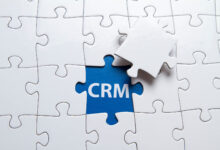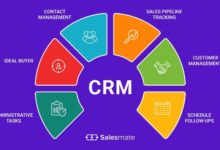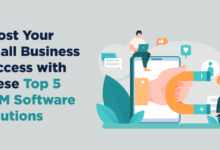Best Enterprise CRM Solutions: A Comprehensive Guide
Best Enterprise CRM Solutions are crucial for large organizations navigating the complexities of modern customer relationship management. This guide delves into the essential features, leading vendors, and implementation strategies required for successful deployment. We’ll explore how the right CRM can streamline operations, enhance customer engagement, and ultimately drive significant ROI. Understanding the unique needs of various industries, from finance to healthcare, is paramount, and we’ll examine these differences to provide a tailored perspective.
From defining your enterprise CRM needs and selecting the right vendor, to mastering implementation and measuring success, this guide offers a practical roadmap. We’ll explore advanced features like AI-powered insights and predictive analytics, crucial for gaining a competitive edge. Furthermore, we’ll address critical considerations such as data security, integration with other business systems, and the ongoing evolution of CRM technology in the ever-changing business landscape.
Defining Enterprise CRM Needs
Enterprise CRM systems are significantly different from smaller-scale solutions, catering to the unique complexities of large organizations. Understanding these differences is crucial for selecting the right system and achieving a successful implementation. This section will explore the key characteristics that define enterprise CRM needs, the challenges faced by large organizations, and the importance of specific features.
Enterprise CRM distinguishes itself through its ability to manage vast amounts of customer data, intricate workflows, and complex interactions across numerous departments and locations. Unlike smaller solutions designed for a limited number of users and interactions, enterprise CRM solutions are built for scalability, robust security, and seamless integration with existing systems.
Key Differences Between Enterprise and Smaller-Scale CRM
Large organizations face unique challenges in managing customer relationships, stemming from their scale, diverse customer base, and complex internal structures. Data silos, inconsistent processes, and a lack of a unified view of the customer are common problems. Furthermore, the need to comply with various regulations and maintain high security standards adds another layer of complexity. These challenges necessitate a robust and adaptable CRM system capable of handling vast quantities of data and supporting numerous users and interactions across multiple departments.
Scalability and Integration in Enterprise CRM
Scalability is paramount in an enterprise CRM system. The ability to adapt to growing data volumes, increasing user numbers, and expanding business operations is essential for long-term success. A scalable system should be able to handle peaks in demand without performance degradation and should allow for easy expansion as the business grows. This often involves utilizing cloud-based infrastructure and employing robust database technologies.
Integration is equally crucial. An enterprise CRM should seamlessly integrate with existing systems, such as ERP, marketing automation, and customer support platforms. This integration prevents data silos, ensures data consistency, and streamlines workflows. For instance, seamless integration with an ERP system can provide real-time insights into inventory levels, allowing sales teams to accurately manage customer expectations. A lack of proper integration can lead to duplicated efforts, data inconsistencies, and ultimately, a diminished customer experience.
Enterprise CRM in Specific Industries
Several industries heavily rely on enterprise CRM for effective customer relationship management. Financial services, healthcare, and manufacturing are prime examples where robust CRM systems are not just beneficial but essential for operational efficiency and customer satisfaction.
| Industry | Data Management Needs | Integration Requirements | Specific CRM Features |
|---|---|---|---|
| Finance | High volume of transactional data, stringent regulatory compliance requirements, sensitive customer information. | Integration with payment gateways, financial reporting systems, and regulatory compliance tools. | Security features, audit trails, reporting and analytics capabilities for regulatory compliance. |
| Healthcare | Patient records, medical history, insurance information, appointment scheduling, and communication with patients and providers. | Integration with electronic health records (EHR) systems, billing systems, and insurance providers. | Patient portal integration, secure messaging, HIPAA compliance features. |
| Manufacturing | Customer orders, inventory management, supply chain data, production scheduling, and after-sales service. | Integration with ERP systems, supply chain management systems, and production planning tools. | Inventory tracking, order management, service request tracking, and real-time production updates. |
Top Enterprise CRM Features
Selecting the right enterprise CRM involves careful consideration of its core functionalities. A robust system goes beyond basic contact management; it empowers businesses to streamline operations, enhance customer relationships, and drive revenue growth. This section details essential and advanced features crucial for maximizing the return on investment in an enterprise CRM solution.
Leading enterprise CRM solutions offer a comprehensive suite of features designed to address the diverse needs of large organizations. These features are categorized broadly into core functionalities and advanced capabilities that leverage modern technologies to improve efficiency and decision-making.
Essential CRM Features
A strong foundation is crucial. These core features are the building blocks of any effective enterprise CRM system. Their implementation ensures basic operational efficiency and data organization.
- Contact Management: Centralized storage and management of customer data, including contact details, communication history, and interactions across various channels.
- Sales Force Automation (SFA): Tools to manage sales processes, track leads, forecast sales, and automate repetitive tasks like email marketing and follow-ups.
- Customer Service Management (CSM): Capabilities for managing customer support interactions, tracking issues, resolving problems efficiently, and measuring customer satisfaction.
- Marketing Automation: Tools to automate marketing campaigns, personalize customer communications, and track the effectiveness of marketing efforts.
- Reporting and Analytics: Dashboards and reports to provide insights into sales performance, customer behavior, and other key metrics.
Advanced CRM Features and Their Benefits
Beyond the core functionalities, advanced features significantly enhance an enterprise CRM’s capabilities, enabling more strategic decision-making and operational optimization. These features often leverage artificial intelligence and machine learning to automate processes and provide predictive insights.
- AI-powered Insights: Leveraging AI algorithms to analyze vast amounts of customer data, identify trends, and provide actionable insights into customer behavior and preferences. For example, an AI system might predict which customers are most likely to churn based on their past interactions and engagement patterns. This allows for proactive intervention and retention strategies.
- Predictive Analytics: Using historical data and statistical modeling to predict future outcomes, such as sales forecasts, customer churn, and marketing campaign effectiveness. A retailer, for example, could use predictive analytics to forecast demand for specific products based on seasonal trends and past sales data, optimizing inventory management and avoiding stockouts or overstocking.
- Workflow Automation: Automating repetitive tasks and processes, such as lead assignment, follow-up emails, and report generation, freeing up employees to focus on more strategic activities. Automating invoice generation and sending reminders, for example, reduces administrative burden and improves efficiency.
Robust Security and Data Privacy Measures
Enterprise CRM systems handle sensitive customer data, making robust security and data privacy measures paramount. Protecting this information is crucial for maintaining customer trust and complying with regulations like GDPR and CCPA.
- Data Encryption: Protecting data both in transit and at rest using encryption technologies to prevent unauthorized access.
- Access Controls: Implementing role-based access control (RBAC) to restrict access to sensitive data based on user roles and responsibilities.
- Data Backup and Recovery: Regularly backing up data to prevent data loss in case of system failures or cyberattacks. Having a robust disaster recovery plan is also critical.
- Compliance Certifications: Seeking certifications like ISO 27001 or SOC 2 to demonstrate a commitment to data security and privacy.
Enterprise CRM UI/UX Design Considerations
The user interface and user experience (UI/UX) are critical factors in the adoption and effectiveness of an enterprise CRM system. A well-designed system enhances user productivity and satisfaction.
- Intuitive Navigation: A simple and intuitive interface that allows users to easily find the information they need and perform tasks efficiently.
- Personalization: Allowing users to customize their dashboards and views to fit their individual needs and workflows.
- Mobile Accessibility: Providing access to the CRM system through mobile devices, enabling users to stay connected and productive on the go.
- Integration with Other Systems: Seamless integration with other enterprise systems, such as ERP and marketing automation platforms, to provide a unified view of customer data.
Leading Enterprise CRM Vendors
Choosing the right Enterprise CRM is crucial for business success. The market offers a diverse range of solutions, each with its own strengths and weaknesses. Understanding the key players and their offerings is essential for making an informed decision. This section will profile five leading vendors and their flagship CRM products.
Leading Enterprise CRM Vendors and Their Products
Selecting a suitable Enterprise CRM requires careful consideration of various factors. A vendor’s reputation, product features, pricing model, and overall suitability for your specific business needs are all critical elements in the decision-making process. The following table provides a comparative overview of five major players in the enterprise CRM market.
| Vendor Name | Product Name | Key Strengths | Key Weaknesses |
|---|---|---|---|
| Salesforce | Salesforce Sales Cloud | Extensive functionality, robust ecosystem of apps and integrations, strong market presence, highly customizable. | Can be expensive, complex to implement and manage, requires significant training. |
| Microsoft | Dynamics 365 | Seamless integration with other Microsoft products, relatively user-friendly interface, strong support network. | Customization can be limited compared to Salesforce, some features may require separate licensing. |
| SAP | SAP CRM | Powerful functionality for large enterprises, strong focus on integration with other SAP products, robust reporting capabilities. | Steep learning curve, complex implementation, can be expensive. |
| Oracle | Oracle Siebel CRM | Mature and feature-rich platform, strong in customer service and support, robust data management capabilities. | Can be expensive, complex to implement and maintain, user interface can be dated. |
| Adobe | Adobe Experience Cloud | Strong focus on customer experience management, excellent marketing automation capabilities, powerful analytics. | Can be complex to implement and integrate with existing systems, requires specialized skills. |
Pricing Models Comparison
Pricing models for enterprise CRM solutions vary significantly. Understanding the different options—subscription-based, perpetual licenses, or a combination thereof—is crucial for budgeting and long-term cost planning. The following chart illustrates the pricing models of three leading vendors.
| Vendor | Pricing Model | Description |
|---|---|---|
| Salesforce | Subscription-based | Typically offered as a monthly or annual subscription fee, based on the number of users and features. Offers various tiers with different functionalities. |
| Microsoft Dynamics 365 | Subscription-based | Similar to Salesforce, with various licensing options and tiers based on user needs and features. Often integrates with existing Microsoft licenses. |
| SAP CRM | Subscription-based and Perpetual Licenses | Offers both subscription and perpetual license options, with perpetual licenses typically involving a one-time purchase and ongoing maintenance fees. Subscription models are increasingly common. |
Implementation and Integration Considerations
Successfully implementing an enterprise CRM system requires careful planning and execution. A phased approach, coupled with robust change management strategies, is crucial for minimizing disruption and maximizing user adoption. Ignoring these considerations can lead to project delays, budget overruns, and ultimately, a system that fails to deliver its intended value.
Implementing a new enterprise CRM system involves a multifaceted process demanding meticulous attention to detail. Failure to address critical aspects such as data migration, integration with existing systems, and user training can significantly impact the project’s success. A well-defined implementation plan, clear communication, and ongoing support are essential for a smooth transition.
Data Migration and Cleansing
Data migration is the process of transferring data from legacy systems into the new CRM. This is often a complex undertaking, particularly for large organizations with extensive data repositories. Data cleansing, on the other hand, involves identifying and correcting inaccuracies, inconsistencies, and duplicates within the data. Both processes are critical to ensuring data quality and accuracy within the new CRM system. Without clean, accurate data, the CRM’s analytical capabilities are severely hampered, leading to poor decision-making. A thorough data assessment should be conducted prior to migration to identify potential issues and develop a comprehensive data cleansing strategy. This might involve deduplication techniques, data standardization, and the creation of data validation rules. For example, a company migrating customer data from multiple spreadsheets might find inconsistencies in address formats or duplicate entries, necessitating a robust cleansing process before the data is loaded into the CRM.
CRM Integration with Other Business Applications
Integrating the enterprise CRM with other business applications, such as ERP (Enterprise Resource Planning) and marketing automation platforms, is crucial for creating a unified view of the customer and streamlining business processes. Integration eliminates data silos, enabling seamless information flow between different systems. This improves operational efficiency, reduces manual data entry, and enhances the overall customer experience. For instance, integrating CRM with an ERP system can provide real-time access to inventory levels, order history, and financial data, enriching the customer profile and enabling more informed sales and service interactions.
Integrating CRM with a Marketing Automation Platform: A Step-by-Step Guide
Integrating a CRM with a marketing automation platform automates marketing tasks, personalizes customer interactions, and provides valuable insights into marketing campaign performance. This integration allows marketers to segment audiences based on CRM data, personalize marketing messages, and track campaign effectiveness.
- Define Integration Goals: Clearly articulate the specific objectives for integrating the CRM and marketing automation platform. This could include automating email marketing campaigns, lead scoring, or reporting on marketing ROI.
- Select Integration Method: Choose an appropriate integration method, such as direct API integration, a pre-built connector, or a third-party integration platform. The choice depends on the technical capabilities of both systems and the organization’s IT resources.
- Data Mapping: Map the relevant data fields between the CRM and marketing automation platform. This ensures that data is transferred accurately and consistently between the two systems. For example, ensure that customer IDs, email addresses, and other key data points are correctly mapped.
- Develop and Test Integration: Develop the integration using the chosen method, and thoroughly test it to ensure data integrity and functionality. This includes testing data synchronization, data transformations, and error handling.
- Deploy and Monitor: Deploy the integrated system and continuously monitor its performance. This involves tracking data transfer rates, identifying and resolving errors, and making necessary adjustments to optimize the integration.
Measuring Success and ROI
Implementing an enterprise CRM system represents a significant investment. Therefore, accurately measuring its success and return on investment (ROI) is crucial for justifying the expenditure and ensuring ongoing optimization. This section outlines key performance indicators (KPIs), ROI calculation methods, successful implementation examples, and a framework for evaluating overall effectiveness.
Key Performance Indicators (KPIs) for CRM Effectiveness
Tracking the right KPIs provides quantifiable data to assess the impact of your CRM system. These metrics should align with your overarching business goals and be regularly monitored. A well-rounded KPI strategy considers both quantitative and qualitative data.
- Lead Conversion Rate: This measures the percentage of leads that convert into paying customers. A higher conversion rate indicates improved lead nurturing and sales effectiveness.
- Customer Acquisition Cost (CAC): This represents the total cost of acquiring a new customer. Lowering CAC demonstrates improved efficiency in marketing and sales processes.
- Customer Lifetime Value (CLTV): This metric predicts the total revenue a customer will generate throughout their relationship with the company. A higher CLTV indicates customer loyalty and retention success.
- Sales Cycle Length: This tracks the time it takes to close a deal. Reducing the sales cycle length signifies improvements in sales efficiency and process optimization.
- Customer Satisfaction (CSAT): This measures customer happiness through surveys and feedback. High CSAT scores indicate effective customer service and relationship management.
- Employee Satisfaction with CRM: This gauges user adoption and satisfaction with the CRM system itself. High satisfaction levels contribute to increased productivity and data accuracy.
Return on Investment (ROI) Calculation
Calculating the ROI of a CRM system requires careful consideration of both costs and benefits. A simple ROI calculation can be expressed as follows:
ROI = (Net Benefits – Total Costs) / Total Costs * 100%
Determining “Net Benefits” involves quantifying improvements in areas like increased sales, reduced customer acquisition costs, improved customer retention, and enhanced operational efficiency. “Total Costs” include the initial software license fees, implementation costs, training expenses, and ongoing maintenance fees. For example, if a company invests $50,000 in a CRM and sees a $100,000 increase in sales revenue within a year, the ROI would be 100%.
Examples of Successful CRM Implementations
Several companies have successfully leveraged CRM systems to achieve significant business improvements. For instance, Salesforce, as a company, utilizes its own CRM to manage its extensive customer base and sales processes, demonstrating a clear alignment between their product and their internal operations. Similarly, many large enterprises such as Amazon and Apple have implemented customized CRM solutions to streamline operations and enhance customer relationships, resulting in improved sales, increased customer loyalty, and better operational efficiency. These successes are often attributed to careful planning, thorough user training, and ongoing optimization based on KPI monitoring.
Framework for Evaluating CRM Effectiveness
A comprehensive evaluation framework should encompass several key areas:
- Data Accuracy and Completeness: Assess the quality of data stored within the CRM system. Inaccurate or incomplete data renders the system less effective.
- User Adoption and Engagement: Measure the extent to which employees are using and benefiting from the CRM system. Low adoption rates indicate potential usability issues or lack of training.
- Process Efficiency and Automation: Evaluate whether the CRM system has streamlined business processes and automated repetitive tasks, leading to increased efficiency.
- Integration with Other Systems: Assess the seamlessness of integration with other enterprise systems, such as ERP and marketing automation platforms. Poor integration can hinder data flow and overall effectiveness.
- Reporting and Analytics Capabilities: Evaluate the system’s ability to generate meaningful reports and insights, enabling data-driven decision-making.
Future Trends in Enterprise CRM
The enterprise CRM landscape is constantly evolving, driven by technological advancements and shifting customer expectations. Understanding these emerging trends is crucial for businesses aiming to maintain a competitive edge and leverage the full potential of their CRM systems. This section explores key future trends and their implications for enterprise CRM strategies.
Impact of Cloud Computing, Artificial Intelligence, and Machine Learning
Cloud computing continues to be a cornerstone of modern enterprise CRM deployments, offering scalability, cost-effectiveness, and accessibility. The move to cloud-based solutions allows for seamless integration with other cloud services and facilitates data-driven decision-making. Simultaneously, the integration of AI and machine learning is revolutionizing CRM functionalities. AI-powered chatbots provide instant customer support, while machine learning algorithms analyze vast datasets to predict customer behavior, personalize marketing campaigns, and optimize sales processes. For example, Salesforce Einstein leverages AI to provide sales insights, predict lead scoring, and automate routine tasks, improving sales team efficiency and productivity. The combination of cloud infrastructure and AI/ML capabilities creates a powerful synergy, enabling more intelligent and responsive CRM systems.
The Growing Importance of Customer Experience Management (CEM)
Customer experience (CX) is no longer a secondary consideration; it’s a central pillar of successful business strategies. Enterprise CRM is increasingly viewed as a critical tool for CEM, enabling businesses to gather comprehensive customer data, understand customer journeys, and personalize interactions across all touchpoints. Effective CEM strategies leverage CRM data to identify areas for improvement in the customer journey, anticipate customer needs, and proactively address potential issues. For instance, a company might use CRM data to identify customers at risk of churn and proactively reach out with tailored offers or support. The focus is shifting from simply managing customer relationships to actively enhancing the customer experience at every stage.
Predicted Evolution of Enterprise CRM over the Next Five Years
Imagine a visual representation: A central sphere representing the current state of enterprise CRM, encompassing core functionalities like sales, marketing, and customer service. From this sphere, several tendrils extend outwards, representing emerging trends. One tendril showcases the expanding integration of AI and machine learning, leading to more predictive and personalized CRM capabilities. Another highlights the growing emphasis on CEM, resulting in a more holistic and customer-centric approach. A third shows the continued migration to the cloud, with increasingly sophisticated cloud-based solutions offering enhanced scalability and flexibility. Finally, a fourth tendril represents the rise of hyper-personalization, where CRM systems use real-time data to deliver highly tailored experiences to individual customers. Over the next five years, these tendrils will grow and intertwine, creating a more interconnected and intelligent enterprise CRM ecosystem. Companies like Adobe and Oracle are already investing heavily in these areas, demonstrating a clear industry-wide trend toward integrated, AI-powered, and customer-centric CRM solutions. The predicted outcome is a more proactive, predictive, and personalized CRM system, capable of anticipating customer needs and delivering seamless, omnichannel experiences.
Last Point
Ultimately, selecting and implementing the best enterprise CRM solution requires careful planning and a deep understanding of your organization’s specific needs. By carefully considering the factors discussed – from essential features and vendor capabilities to implementation strategies and ROI measurement – businesses can leverage CRM technology to optimize customer relationships, improve operational efficiency, and achieve sustainable growth. The journey to a more efficient and customer-centric organization begins with the right CRM, and this guide provides the essential knowledge to navigate that path successfully.




